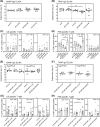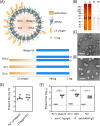Ultra-low dose immunization and multi-component vaccination strategies enhance protection against malaria in mice
- PMID: 34031479
- PMCID: PMC8144388
- DOI: 10.1038/s41598-021-90290-8
Ultra-low dose immunization and multi-component vaccination strategies enhance protection against malaria in mice
Abstract
An effective vaccine would be a valuable tool for malaria control and elimination; however, the leading malaria vaccine in development, RTS,S/AS01, provided only partial protection in a Phase 3 trial. R21 is a next-generation RTS,S-like vaccine. We have previously shown in mice that R21 administered in Matrix-M is highly immunogenic, able to elicit complete protection against sporozoite challenge, and can be successfully administered with TRAP based viral-vectors resulting in enhanced protection. In this study, we developed a novel, GMP-compatible purification process for R21, and evaluated the immunogenicity and protective efficacy of ultra-low doses of both R21 and RTS,S when formulated in AS01. We demonstrated that both vaccines are highly immunogenic and also elicit comparable high levels of protection against transgenic parasites in BALB/c mice. By lowering the vaccine dose there was a trend for increased immunogenicity and sterile protection, with the highest dose vaccine groups achieving the lowest efficacy (50% sterile protection). We also evaluated the ability to combine RTS,S/AS01 with TRAP based viral-vectors and observed concurrent induction of immune responses to both antigens with minimal interference when mixing the vaccines prior to administration. These studies suggest that R21 or RTS,S could be combined with viral-vectors for a multi-component vaccination approach and indicate that low dose vaccination should be fully explored in humans to maximize potential efficacy.
Conflict of interest statement
KA Collins, SC Gilbert, AVS Hill are named as co-inventors on a patent filing related to the R21 immunogen; SC Gilbert and AVS Hill are co-inventors on patents relating the ME.TRAP vectored vaccines; D Franco and WR Ballou are employees of the GSK group of companies and WR Ballou reports owning shares and/or restricted shares in GSK. All other authors declare no competing financial interests.
Figures






Similar articles
-
Enhancing protective immunity to malaria with a highly immunogenic virus-like particle vaccine.Sci Rep. 2017 Apr 19;7:46621. doi: 10.1038/srep46621. Sci Rep. 2017. PMID: 28422178 Free PMC article.
-
Fractional Third and Fourth Dose of RTS,S/AS01 Malaria Candidate Vaccine: A Phase 2a Controlled Human Malaria Parasite Infection and Immunogenicity Study.J Infect Dis. 2016 Sep 1;214(5):762-71. doi: 10.1093/infdis/jiw237. Epub 2016 Jun 13. J Infect Dis. 2016. PMID: 27296848 Clinical Trial.
-
The biological function of antibodies induced by the RTS,S/AS01 malaria vaccine candidate is determined by their fine specificity.Malar J. 2016 May 31;15:301. doi: 10.1186/s12936-016-1348-9. Malar J. 2016. PMID: 27245446 Free PMC article.
-
The RTS,S/AS01 malaria vaccine in children 5 to 17 months of age at first vaccination.Expert Rev Vaccines. 2016 Dec;15(12):1481-1493. doi: 10.1080/14760584.2016.1236689. Expert Rev Vaccines. 2016. PMID: 27841689 Review.
-
[The RTS,S/AS01 malaria vaccine in children aged 5-17 months at first vaccination].Pan Afr Med J. 2018 Jun 19;30:142. doi: 10.11604/pamj.2018.30.142.13152. eCollection 2018. Pan Afr Med J. 2018. PMID: 30374388 Free PMC article. Review. French.
Cited by
-
The effect of dosage on the protective efficacy of whole-sporozoite formulations for immunization against malaria.NPJ Vaccines. 2023 Nov 24;8(1):182. doi: 10.1038/s41541-023-00778-9. NPJ Vaccines. 2023. PMID: 37996533 Free PMC article.
-
Germinal center activity and B cell maturation are associated with protective antibody responses against Plasmodium pre-erythrocytic infection.PLoS Pathog. 2022 Jul 6;18(7):e1010671. doi: 10.1371/journal.ppat.1010671. eCollection 2022 Jul. PLoS Pathog. 2022. PMID: 35793394 Free PMC article.
-
Establishing RTS,S/AS01 as a benchmark for comparison to next-generation malaria vaccines in a mouse model.NPJ Vaccines. 2024 Feb 10;9(1):29. doi: 10.1038/s41541-024-00819-x. NPJ Vaccines. 2024. PMID: 38341502 Free PMC article.
-
A Head-to-Head Comparative Study of the Replication-Competent Vaccinia Virus and AAV1-Based Malaria Vaccine versus RTS,S/AS01 in Murine Models.Vaccines (Basel). 2024 Oct 10;12(10):1155. doi: 10.3390/vaccines12101155. Vaccines (Basel). 2024. PMID: 39460322 Free PMC article.
-
Sterile protection and transmission blockade by a multistage anti-malarial vaccine in the pre-clinical study.Front Immunol. 2022 Sep 29;13:1005476. doi: 10.3389/fimmu.2022.1005476. eCollection 2022. Front Immunol. 2022. PMID: 36248835 Free PMC article.
References
Publication types
MeSH terms
Substances
Grants and funding
LinkOut - more resources
Full Text Sources
Other Literature Sources
Medical

